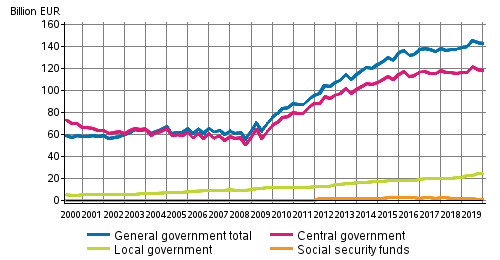Published: 16 March 2020
General government debt fell by EUR 1.2 billion in the last quarter of 2019
General government EDP debt, or consolidated gross debt at nominal prices, amounted to EUR 142.5 billion at the end of the last quarter of 2019 and fell by EUR 1.2 billion during the quarter. Correspondingly, general government debt has grown by EUR 3.2 billion compared with the respective period of the year before. These data derive from Statistics Finland's statistics on general government debt by quarter.
General government debt by quarter

During the last quarter, central government debt decreased by EUR 1.0 billion and was EUR 118.2 billion at the end of the quarter. The stock of short-term loans went down by EUR 0.4 billion, and the stock of long-term loans decreased by EUR 0.3 billion. In addition, the deposit stock fell by EUR 0.3 billion during the quarter. Central government decreased the stock of short-term debt securities by EUR 0.5 billion and increased long-term debt securities by the equal amount.
The local government sector's debt fell by EUR 0.1 billion and totalled EUR 24.2 billion at the end of the quarter. The number of short-term debt instruments decreased by EUR 0.4 billion and the loan stock grew by EUR 0.3 billion. Social security funds' debt grew by EUR 0.1 billion and totalled EUR 1.4 billion at the end of the quarter. Of them, employment pension schemes' debt grew by EUR 0.2 billion due to cash collateral received in connection with derivative contracts and securities lending. The debt of other social security funds decreased by EUR 0.2 billion, when all the remaining debt securities matured.
General government EDP debt describes general government’s debt to other sectors of the national economy and to the rest of the world, and its development is influenced by changes in unconsolidated debt and internal general government debts. Consolidated general government gross debt is derived by deducting debts between units recorded under general government from unconsolidated gross debt. For this reason, general government debt is smaller than the combined debts of its sub-sectors.
The EDP debt of general government differs conceptionally to some extent in the case of central government from the central government debt published by the State Treasury. Central government's EDP debt also includes loans granted to beneficiary counties by the European Financial Stability Facility EFSF, received cash collaterals related to derivative contracts, the capital of the Nuclear Waste Management Fund, debts generated from investments in central government's PPP (public-private partnership) projects, coins that are in circulation, and the deposits of the European Commission. In National Accounts, central government is also a broader concept than the budget and financial economy (http://www.stat.fi/meta/luokitukset/_linkki/julkisyhteisot.html). However, the State Pension Fund is included in social security funds. The valuation principle for both debt concepts is the nominal value, where the effect of currency swaps is taken into account.
Source: General government debt by quarter, Statistics Finland
Inquiries: Aaro Hottinen 029 551 3231, Jose Lahtinen 029 551 3776, financial.accounts@stat.fi
Director in charge: Jan Nokkala
Publication in pdf-format (218.1 kB)
- Tables
-
Tables in databases
Pick the data you need into tables, view the data as graphs, or download the data for your use.
Appendix tables
- Revisions in these statistics
-
- Revisions in these statistics (16.3.2020)
Updated 16.3.2020
Official Statistics of Finland (OSF):
General government debt by quarter [e-publication].
ISSN=1799-8034. 4th quarter 2019. Helsinki: Statistics Finland [referred: 25.12.2025].
Access method: http://stat.fi/til/jyev/2019/04/jyev_2019_04_2020-03-16_tie_001_en.html

